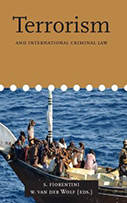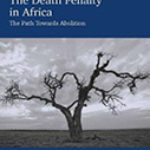Terrorism and International Criminal Law

Editors: S. Fiorentini & W. Van Der Wolf
Publisher: The Hague: International Courts Association Press, 2013. 294p.
Reviewer: Stéphane Lefebvre | January 2015
Terrorism and International Criminal Law is the latest book published by the International Courts Association as part of its international criminal law series. Founded in 1986 in The Hague, the Association promotes the work of international and regional courts through a variety of publishing activities, including books of a more general nature that would appeal to a wide audience. The book under review falls within the latter category. This, of course, has both strengths and weaknesses. On the positive side, it is easy to read, and, for the non-jurists, to grasp key international law concepts. On the negative side, it remains, in line with the Association’s mandate, an advocacy effort without the benefit of in-depth scholarly research and fully supported arguments.
The Association’s pitch is made in the first 69 pages. The remainder of the book contains the full text of international conventions related to terrorism. The argument can be summarized as follows. Although the international community has put in place many conventions and issued an endless number of declarations, resolutions and statements, it has yet to fully tackle the international crime of terrorism at the international level by assigning its prosecution to an international criminal court to complement domestic anti-terrorism judicial proceedings. In the absence of such a mechanism, the international community has not yet been successful in deterring actual and potential terrorists. The absence of an internationally agreed definition of terrorism, largely due to a lack of will by the United Nations, is not an unsurmountable obstacle. In point of fact, in 2011 the Appeals Chamber of the Special Tribunal for Lebanon, under the leadership of the late Antonio Cassese, used an interpretive approach based on semiotics to come up with a customary international law definition of terrorism.
The book’s argument, unfortunately, is not all that well supported. For example, at page 2, the editors note quite accurately that the Appeals Chamber ruling was controversial. Yet chapter 4, which discusses the ruling, is only four pages and a half, and fails to discuss the controversial aspects of the ruling. Furthermore, the chapter has no scholarly or popular references on the controversy, which is in contrast with other chapters that have standard references. The notion that the mere existence of an international criminal court to prosecute terrorists would deter future acts of terrorism should have been stated as an assumption and not a fact. There are no empirical data to suggest that actual and potential terrorists think rationally, know what is harmful to them, learn from the convictions of others, and understand the potential consequences of their actions.1 This is not to say that an international criminal court would be entirely ineffective; rather this is to acknowledge, as the editors should have done, that the deterrent effect of the law is a complex issue and should not be taken for granted.
The last two chapters of the books on the rights of suspected terrorists and piracy are also unsatisfactory. Although very factual and without any serious limitations, they are simply out of date, and by a wide margin. For example, when discussing the United Nations Security Council Resolution 1267 and due process, the book fails to not only discuss but to even mention the Office of the Ombudsperson created pursuant to United Nations Security Council Resolution 1904 (2009), which has a key role to play in the delisting process. On piracy, chapter 6 notes an upsurge in privacy, although the number of piracy incidents in 2012 was 75% lower than the number of incidents in 2011. Further is the statement that the nations patrolling the Gulf of Aden were not prosecuting pirates; and yet, since 2010 the United States has charged 25 pirates and convicted 17 in the US Eastern District of Virginia. A book published in 2013 should not be so factually out of date.
While the Association’s objective to promote international courts is a valuable one, it would further its cause to produce written material that is more up to date and of better quality than the book under review. To have the full text of international conventions related to terrorism in one book is useful. But more effort to place them in context is required. Jurists, international law and national security experts will not find much that is useful from reading this book. For those who do not know anything about terrorism and international criminal law, this book could serve as a cursory introduction to an important subject, but which will need to be complemented by more rigorous material.
Note
- E.A. Fattah, “Deterrence: A Review of the Literature” in Law Reform Commission of Canada, Fear of Punishment (Ottawa: Minister of Supply and Services Canada, 1976), 10-12; Stephen E Brown & Finn-Aage Esbensen, “Thoughts on Deterrence: Evolution of a Theoretical Perspective” International Journal of Offender Therapy and Comparative Criminology 32 (1988), 223.
Stéphane Lefebvre is a PhD candidate at the Department of Law & Legal Studies of Carleton University in Ottawa, Canada. He has published over 20 book chapters and journal articles and over 80 book reviews.


